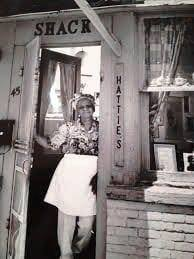A Skillet, $33, and a Dream: The Journey of Hattie Moseley Austin
In the year 1938, a woman named Hattie Moseley Austin arrived in Saratoga Springs, New York, stepping off a bus into an uncertain future. She carried no entourage, no recipe book, no connections—only $33, a battered cast-iron skillet, and memories of flavors from her youth in Louisiana. She had never formally learned how to cook those soul-rich dishes; she had simply tasted them as a girl, absorbing their essence. Now, she would endeavor to turn memory into sustenance.
From Orphan to Survivor: The Early Years
Hattie’s beginnings were far from easy. Orphaned at a young age, she understood hardship early. She fended for herself, working as a domestic help, cleaning houses, cooking, and doing whatever labor she could find. Through the Great Depression, her resources deteriorated, but her resilience never wavered.
Though she lacked formal culinary training or wealthy backers, Hattie held onto something invaluable: persistence, an unshakable spirit, and love for the comforting flavors she remembered from childhood meals.
Landing in Saratoga Springs: The Bold Leap

With only modest funds and one trusted skillet, Hattie disembarked in Saratoga Springs. She didn’t know precisely where she’d sleep that night or where her next meal would come from. But she believed she could turn her memories into something nourishing—and into something people would want.
She rented a small space and, working around the clock, launched a modest 24-hour food stand. Her offerings were simple: fried chicken, cornbread, and biscuits—dishes she described as “warm hugs from home.” She relied heavily on intuition, adjusting seasonings by taste, working long hours, serving whoever came through the door.
More Than Food: The Power of Warmth
As days turned into weeks, more customers trickled in. Jockeys heading to the racetrack, local patrons, tourists passing through—all were drawn by the aromas and the promise of genuine hospitality. It wasn’t just that her food was good: it was how she made diners feel. She greeted people like old friends, offered second helpings, and made sure no one left hungry or unloved. Over time, this personal warmth became as much a draw as the food itself.
Eventually, the stand evolved into a full-fledged restaurant. Word spread: “You have to try the place where the fried chicken is magical.” But the secret wasn’t really in secret spices or techniques—it was in Hattie’s spirit and in the dignity she extended to every single customer.
Visitors, Luminaries, and Legacy
Her restaurant became a locus of community and culture. Jockeys from the nearby track dropped in. Jazz musicians grabbed a bite between sets. Local residents made it a staple. Even prominent figures—celebrities and artists—heard of her reputation and came to sample what everyone was whispering about.
Over the years, she remained hands-on, working tirelessly. She persisted even into her 90s, sustained by her passion for feeding people. When she finally slowed her pace, her restaurant endured. Even long after she stepped away, Hattie’s Restaurant remained a beloved institution.
Food critics and cultural commentators would later acclaim her fried chicken as among the finest in the country. But anyone who had sat at her table, felt her warmth, or heard her stories knew: the true recipe was never just in the kitchen. It was in her soul—in generosity, in connection, in a steadfast belief that nourishment is about more than calories.